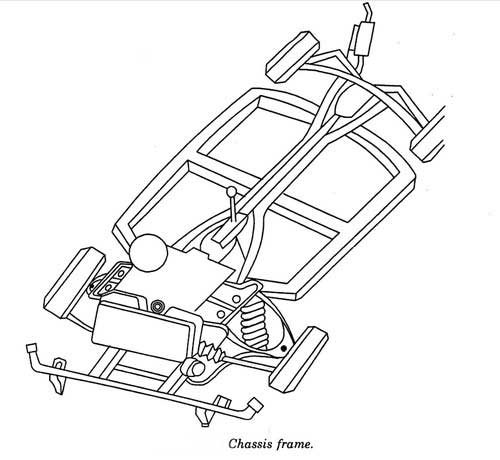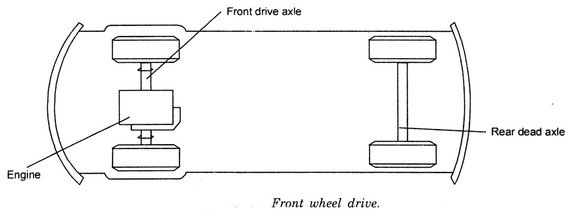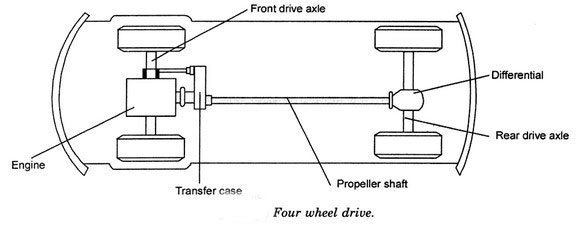In this article, you will learn in details about the components and parts of automobile. Keep reading.
Table of Contents
Components, Parts of Automobile.
An automobile has several numbers of parts. But there are four essential components of automobile. These are:
1. The Chassis.
2. The Engine.
3. The Transmission System.
4. The Body.
Apart from these four essential parts of automobile, there are controls and auxiliaries.
The controls are meant for controlling the movement of the vehicle. The auxiliaries are additional components meant for providing comfort to the user of the automobile.
1. The Chassis.
The chassis of an automobile incorporates all the major assemblies consisting of an engine, components of transmission system such as clutch, gearbox, propeller shaft, axles, a control system such as brakes and steering, and suspension system of the vehicle.
In other words, it is the vehicle without its body.

The chassis of an automobile has the frame, suspension system, axles, and wheel as the main components. The frame could be in the form of conventional chassis or unit construction may be adopted.
In a conventional chassis frame, the frame forms the main skeleton of vehicle. It supports engine, power transmission, and car body.
The frame is supported on wheels and axles through springs. The frame carries the weight of the vehicle and passengers, withstands engine, transmission, accelerating, and braking torques.
It also withstands the centrifugal forces while cornering and takes up stresses due to the rise and fall of axles.
In the unit construction type, there is no frame. The structure of the body of the automobile is first formed, and then different components such as the engine, transmission system, and other parts are placed at suitable places in the body structure.
The transmission system itself consists of a number of parts such as clutch assembly, gearbox, propeller shaft, differential, and axles.
The other parts include the interior details which are utilized by the passengers and driver of the vehicle. Through suitable designing, the parts are so arranged that they provide maximum comfort and make journeys in the automobile enjoyable.
The other parts of the chassis are suspension system, axles, and wheel. The suspension system absorbs the vibrations due to up and down movement of wheels.
Springs and shock absorbers connecting the frame and the axle perform this function. The springs can be leaf spring, coil spring, or torsion bar. Even rubber or air can form the material of springs.
The wheels of the vehicle can be suspended independently on springs or on spring-suspended axles. The axle may be ‘live’ if power from the engine is transmitted to it.
It may be a ‘dead’ axle if no power is supplied to it and it is just supporting the weight of the vehicle. In ‘four-wheel drive,’ the power is supplied to both the axles and therefore both the axles are ‘live.’
In addition to providing support to the weight of the vehicle, the axle also resists the stresses due to braking and driving torque.
2. The Engine.
The engine is the source of motive power to an automobile. Obviously, it is a very important part of the automobile because in the absence of an engine, the automobile may not move at all, and its basic function of transporting passengers or goods would be defeated.
The power of the engine determines the working of the automobile. In the same manner, the efficiency of the engine determines the efficiency of an automobile.
The engine, nowadays, is invariably an internal combustion engine. This may be a spark-ignition engine consuming petrol as fuel.
Alternatively, it could be a compression ignition engine using diesel as fuel.
The engines used are multi-cylinder engines. A single-cylinder engine, though capable of providing the desired power may become very heavy and therefore may be unsuitable.
In a multi-cylinder engine, each cylinder handling a smaller amount of power may keep engine light in weight. In an internal combustion engine, total heat produced by the burning of fuel is not converted into work.
Part of it causes over-all heating of engine which is undesirable. This heat is to be dissipated properly. Coolant in the form of air or water may be used to take away this heat.
So an engine can be air-cooled or water-cooled. These days some chemicals have been developed which have a cooling property, and these remain unaffected for a longer period of time.
These chemicals are being used as coolants, and these do not require frequent replacement. Apart from their long life, they are more efficient also.
Similarly, lubrication is another aspect to be taken care of in an engine requiring periodic attention from the user.
The moving parts in an engine need regular lubrication to reduce unwanted friction. The chemistry of lubricant is now highly developed. There is a standard rating for lubricants and for every purpose a specific lubricant is available.
3. The Transmission System.
The transmission system transmits power developed by the engine to the road wheels. The power available as output from the engine is in the form of rotation of the crankshaft.
This movement is to be transferred to the road wheels to cause their rotary motion. Their rotary motion makes possible the movement of the vehicle.
The transmission system consists of different parts. These include clutch, gearbox, propeller shaft, differential and axle, live axle to be more precise.
The road wheels are at the ends of the axle. The motion is transmitted through these parts. Every part of the transmission system performs its own function.
i. Clutch.
The clutch, part of the transmission system is next to the crankshaft. It is a mechanism enabling the rotary motion of one shaft transmitted to the second shaft ‘at will.’
When the engine starts, it should not be connected to road wheels, i.e., these should not start moving as soon as the engine starts.
Secondly, this motion should be smoothly transferred so that passengers in the car do not feel discomfort, and its mechanism is not spoiled.
In the case of vehicles used for the transportation of goods, the smooth transmission process is essential as otherwise, it may cause damage to goods.
ii. Gearbox.
The gearbox is the component of the transmission system next to the clutch. It has got a gear train, and it provides different gear ratios. These ratios determine the rotary speed of output shaft from the gearbox.
The torque transmitted to the road wheels gives rise to a propulsive force or (tractive effort) between these and the road. When starting from rest, a large tractive effort is required.
This makes essential the introduction of considerable ‘leverage’ between the engine and the wheels so that torque from the engine, which is almost constant, produces the large tractive effort.

This ‘leverage’ is provided by the gearbox.
Different gear ratios available in the gearbox can provide the required tractive effort to overcome the resistance faced by the automobile under different conditions.
Propeller shaft transmits the output from the gearbox to the axle. This axle may be in the rear or in the front or in some cases both the rear and front axle may receive output from the gearbox.
The output from the gearbox is in the form of rotary motion of the shaft, and this motion is transferred to the axle.

iii. Differential.
The differential is the next component of the transmission system. The motion of propeller shaft is fed to the differential which turns it through 90 degrees. This is essential as the axle is at 90 degrees to the propeller shaft.
The function is performed with the help of a pinion and a gear. Another important function of the differential is to reduce the speed of inner wheels and at the same time, enhance the speed of outer wheels by the same amount.
This is required when the automobile is moving on a curved path. On a curved path, the outer wheels are required to traverse a circle of a bigger radius than the inner wheels.
This means that the outer wheels are required to traverse larger distance as compared to inner wheels. As the automobile is to move as a single unit, all the four wheels must travel together.
Therefore, the outer wheels should travel larger distance and inner wheels should travel smaller distance in the same time period.
Hence, the variation in the speed of inner and outer wheels is needed. This is performed by the differential with the help of sun and planet gear system.

iv. Axle.
The axle is the next component of the transmission system. The axle receiving power from the engine is termed as ‘live’ axle. It is in two halves.
The ends of the axle have road wheels connected to it. These road wheels are in direct contact with the road surface. The body of the automobile is above the axle.
The axle also takes up the various loads including the weight of the automobile. It also transmits motion to the road wheels.
4. The Body.
The use of a separate frame to which the body structure is attached is now almost obsolete except for some applications for heavy-duty commercial vehicles.
Many heavy vehicles now use ‘sub-frames’ of simple construction to which the engine and gearbox are attached.
The sub-frame is supported on the mainframe and is fixed on it through some suitable rubber connections to isolate the engine vibrations.
Due to development in spot welding and sheet pressing techniques, most of the vehicles have integral construction. All the assembly units of the vehicles are attached to the body, which also acts the frame.
It makes the vehicle compact, lightweight, and also its cost is reduced. Some intermediate designs using a light chassis and a pressed steel body are also in use.
The light chassis, in such designs, is strengthened by using platform made of a sheet of steel. Apart from the four basic components described above, the automobile has the control systems and auxiliaries.
The control systems are used to control the motion of an automobile and therefore are essential in an automobile. These include;
i. The steering system, and
ii. Braking system or brakes.
i. Steering system.
The automobile, while moving, may be required to traverse a circular path. It has to be turned through some angle if the path is not straight.
There may be other situations also when the road is turning towards left or right, and an automobile is required to turn to left or right.
This turning of the automobile towards left or right or on the curved path is provided through steering mechanism.
The steering system is required to be quite accurate as the automobile should turn accurately along with the path.
ii. Braking system.
This causes a reduction in speed of the vehicle and brings it to rest when necessary. Bringing an automobile to rest is as important as its movement.
Obviously, when we have reached our destination, we would like to stop; and therefore, the vehicle should come to rest.
Also, there may be some kind of emergency and vehicle may be required to slow down or stop on the way. At that time, also its motion is to be controlled.
This control on the motion is provided with the help of brakes.
5. The Auxiliaries.
These are the components of an automobile which may not be essential, but it can make the driving more comfortable.
The fact is that with the passage of time, some auxiliaries become essential. A few years back, the indicators—to indicate the turning vehicle—were not used. But now these have been made mandatory by the government.
Though air-conditioner is not essential and is just to provide comfort conditions, now it is provided in every vehicle in developed countries and is being adopted by more and more people.
The study of automobile engineering involves going through an in-depth study of all the components and parts of automobile.
These include engine, transmission system, control, and auxiliaries system.
The engine used in an automobile is an internal combustion engine. The transmission system consists of a number of parts, the introduction of which has already been presented.
Suspension systems, wheels, and tires are also important components, parts of automobile. Study of steering mechanism and brakes is also important as these form the control system in an automobile.
Am a student of national aerospace university kharkiv Ukraine.Consulting your website is a great relieve for me in my study.Thank you very much.
the best song composition are those who are coming from real experiences
Thank you!!!! Very much…
Thnk you very much your website helps me really I also like if there are some Vedoes
Thnk you very much your website helps me really I also like if there are some Vedoes
This web page has been of great help to me in my studies
Thank you for all basics of automotive. It become good introduction to me for the domain
Thanks alot for providing us such informative and comprehensive basic content…
Nice Piece of Information
Is a pleasure to learn from Here
But please next time used 3D pictures to show illustrations
Thanks ????
This is so helpful.Thank You!!!